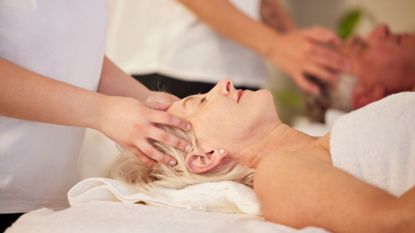Boost the Benefits of Walking for Exercise: Genius Tricks That Rev Metabolism, Ease Stress + More
Trading your evening stroll for a morning walk helps melt pounds and shrink your waist

Nothing beats a leisurely stroll around the block on a nice day. And if you’re anything like us, walking is likely a part of your daily routine. But what if we said that simply upgrading your walk with a fun playlist or change of scenery could boost the benefits? It’s true! While walking exercise routines are great on their own, a few little tweaks can do everything from better your balance to sharpen your memory and more. Here’s how.
What makes walking such good exercise?
Sure, you know that walking keeps your heart and lungs healthy and muscles strong. But the favorite pastime is also a smart way to lift your mood and sharpen your thinking, too. “Walking gets your heart to pump oxygen and nutrients to your brain cells and increases levels of fool-good endorphins,” explains Gary Small, MD, Chair of Psychiatry at Hackensack University Medical Center.
So it’s no wonder that nearly 2 out of 3 of us enjoy taking walks. And with a few small changes to your strolling routine, you can amplify these feel-good, health-boosting perks with every step.
How to boost the benefits of walking for exercise
Ready to take your walking exercise routine to the next level? These are the small tweaks that make a big difference.
1. Shed more pounds in the AM
If you set out on walks to lose excess weight, slip into your sneakers between 7 am and 9 am. Research out of Franklin Pierce University shows that morning walkers weigh less and have waists that are up to 1 ¾ inches slimmer than folks who walk the same amount later in the day. Exercising early on helps your body burn more calories during the rest of the day, plus it reduces your appetite so you naturally eat less.
See also: Studies Prove Group Walking Is Even Better at Boosting Weight Loss — How Your Health Can Benefit
2. Soothe stress by visiting a park

When tension rises, head outdoors and walk around a tree-lined block, through a park or in another area with natural scenery. A study in Environment and Behavior found that pairing nature and physical activity is a potent way to increase calm. “Walking outside exposes us to plants and water that can lower levels of stress through the release of oxytocin, a hormone that boosts mood,” explains Small.
The beauty of nature distracts you from worries, while exercise decreases activity in the brain’s stress-triggering center. The result? You’ll curb release of stress hormone cortisol more than just gazing at nature or walking alone.
Bonus: A study in PLOS ONE shows that taking your dog for a fun trek increases relaxation-activating alpha brain waves, soothing your stress. No dog around? Walking a pup from the local shelter works, too!
3. Solve problems by walking upstairs
If you need a quick fix for a sticky problem, simple walk up some stairs. Research in Frontiers in Behavioral Neuroscience found climbing just 3 flights improves creative thinking, enabling you to come up with 61% more inventive solutions. Carefully placing your feet in certain spots (like the next stair ahead of you) activates the brain’s prefrontal cortex. This sparks imagination and helps you quickly switch between ideas.
Related: Experts Share the 8 Best Brain Foods to Boost Focus, Prevent Memory Loss and More
4. Boost balance by walking at the beach
Love to cool off in summer at a pool, lake or ocean? Scientists reporting in the Korean Journal of Applied Biomechanics found that walking while chest-deep in water improves balance when you get back on land, lowering your risk of falls. The gentle pressure of moving through water tones ankle flexor muscles. This improves the stability of your ankles and lower body, keeping you steadier.
Also smart: Research shows that walking briskly for at least 22 minutes a day reduces your risk of falls by building up physical endurance so you don’t tire out. That’s key, since the body’s postural control mechanism that keeps you upright works more effectively when you’re not fatigued.
5. Sharpen thinking with a walking exercise playlist

Here’s one good reason to listen to music as you walk: Hearing favorite tunes makes your jaunt more enjoyable by increasing energizing beta waves. Another big bonus? A study in PLOS ONE shows that pairing music with walking improves spatial skills. This helps you visualize objects in your mind so you can do tasks like parking a car and reading a map more easily. Researchers suspect adding music to physical exercise stimulates the brain’s parietal lobe (responsible for navigation) more than doing exercise alone, helping it work more effectively.
Not into music? Try slowing down while you stroll instead. In a study from Dartmouth University, folks who regularly take leisurely strolls were found to be better at remembering new information. It may be because of the memory-boosting neurotransmitter that increases when you’re active.
6. Lower blood pressure with a pedometer
Has your doctor said that your blood pressure numbers are creeping up? Attach a pedometer to your hip (or slip on a smartwatch), then aim to get 10,000 steps a day. Even if you don’t reach that amount, Stanford University research shows that you’ll still walk over 2,000 steps more (equal to 1 mile) every day than you would have without the pedometer.
Plus, you’ll lower systolic blood pressure (top number) by nearly 4 points within about 18 weeks. “Pedometers provide feedback that makes people aware of their activity levels so they can set and increase goals to extend their walking distance,” says Small. The payoff: Aerobic exercise — the kind that increases your breathing and heart rate — reduces resistance in arteries, making blood flow easier.
And to boost the benefit, pair up! An analysis in the British Journal of Sports Medicine shows that walking with other people lowers systolic BP by nearly 4 points and diastolic (bottom number) by more than 3 points. Joining a group or teaming up with a friend makes you feel supported, motivating you to walk more.
Related: 20 Easy Ways to Lower Your Blood Pressure Naturally — No Diet or Gym Required
For more ways to tap into the health benefits of walking for exercise:
Get Healthy by Having Fun With Friends? Yes! See Why More Doctors Are Practicing Social Prescribing
Studies Prove Group Walking Is Even Better at Boosting Weight Loss — How Your Health Can Benefit
Fitness Pros Say the Viral Hot Girl Walk Boosts Health, Happiness and Confidence — Here’s Why
This content is not a substitute for professional medical advice or diagnosis. Always consult your physician before pursuing any treatment plan.













